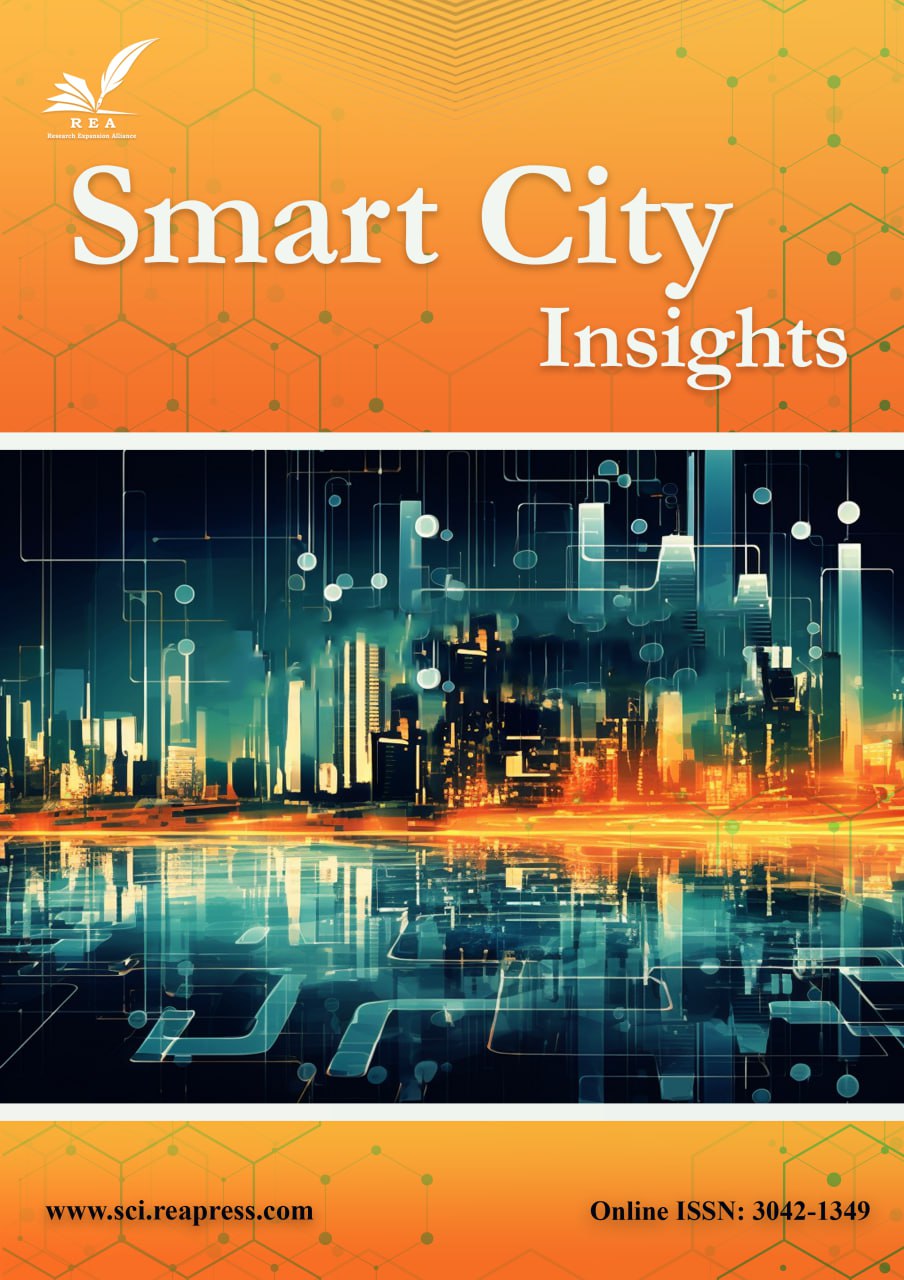Optimization of energy efficiency in smart city IoT sensor networks
Abstract
As urban areas expand, smart city initiatives increasingly rely on IoT sensor networks to monitor and manage resources, optimize traffic, and enhance quality of life. However, these sensor networks face challenges in energy efficiency, which is critical to ensure long-term sustainability, reduce operational costs, and minimize environmental impact. This paper explores strategies to optimize energy efficiency within smart city IoT sensor networks, focusing on low-power protocols, adaptive network topologies, and efficient data transmission methods. This study identifies common energy bottlenecks by analyzing existing smart city implementations and evaluates emerging low-power technologies, such as Narrowband IoT (NB-IoT) and Long Range (LoRa) communication protocols. Further, it examines hardware improvements in sensor design and edge computing's role in reducing transmission energy by processing data closer to the source. Our analysis reveals that a hybrid approach—incorporating both hardware advancements and software optimization strategies—provides the most significant gains in energy efficiency. Additionally, we propose a framework that allows for adaptive power management based on environmental conditions and network demands, thereby enhancing the longevity and scalability of IoT networks in urban contexts. The findings from this study provide valuable insights for policymakers, urban planners, and technologists aiming to build sustainable smart cities, underscoring the importance of energy-aware designs in IoT infrastructure.
Keywords:
Energy efficiency, IoT sensor networks, Smart cities, Sustainability, Low-power protocols, Adaptive network topologies, Edge computingReferences
- [1] Rehan, H. (2023). Internet of things (IoT) in Smart cities: enhancing urban living through technology. Journal of engineering and technology, 5(1), 1−16. https://mzjournal.com/index.php/JET/article/view/70
- [2] Rotimi-Silva, A. M. (2024). Energy harvesting iot sensors for remote renewable energy systems [Thesis]. https://B2n.ir/z39577
- [3] Al-Zurfi, M. A. R., Hilli, A. Al, & Al-Ibadi, M. (2024). Enhancing energy efficiency in wireless sensor networks via adaptive sparse bayesian learning. 2024 15th international conference on computing communication and networking technologies, icccnt 2024 (pp. 1–6). IEEE. https://doi.org/10.1109/ICCCNT61001.2024.10724054
- [4] Mushtaq, M. U., Hong, J., Owais, M., & Danso, S. A. (2023). Enhancing security and energy efficiency in wireless sensor network routing with IoT challenges: A thorough review. LC international journal of stem (ISSN: 2708-7123), 4(3), 1–24. https://doi.org/10.5281/zenodo.10184917
- [5] Almudayni, Z., Soh, B., Samra, H., & Li, A. (2025). Energy inefficiency in IoT networks: causes, impact, and a strategic framework for sustainable optimisation. Electronics, 14(1), 159. https://doi.org/10.3390/electronics14010159
- [6] Bharathi, R., Kannadhasan, S., Padminidevi, B., Maharajan, M. S., Nagarajan, R., & Tonmoy, M. M. (2022). Predictive model techniques with energy efficiency for IoT-based data transmission in wireless sensor networks. Journal of sensors, 2022(1), 3434646. https://doi.org/10.1155/2022/3434646
- [7] Dogra, R., Rani, S., Babbar, H., & Krah, D. (2022). Energy-efficient routing protocol for next-generation application in the internet of things and wireless sensor networks. Wireless communications and mobile computing, 2022(1), 8006751. https://doi.org/10.1155/2022/8006751
- [8] Khalifeh, A., Mazunga, F., Nechibvute, A., & Nyambo, B. M. (2022). Microcontroller unit-based wireless sensor network nodes: A review. Sensors, 22(22), 8937. https://doi.org/10.3390/s22228937
- [9] Al-Sofi, S. J., Atroshey, S. M. S., & Ali, I. A. (2024). IEEE 802.15.6 and LoRaWAN for WBAN in healthcare: A comparative study on communication efficiency and energy optimization. Computers, 13(12), 313. https://doi.org/10.3390/computers13120313
- [10] Bagwari, A., Logeshwaran, J., Usha, K., Raju, K., Alsharif, M. H., Uthansakul, P., & Uthansakul, M. (2023). An enhanced energy optimization model for industrial wireless sensor networks using machine learning. IEEE access, 11, 96343–96362. https://doi.org/10.1109/ACCESS.2023.3311854
- [11] Sahar, G., Bakar, K. A., Rahim, S., Khani, N. A. K. K., & Bibi, T. (2021). Recent advancement of data-driven models in wireless sensor networks: A survey. Technologies, 9(4), 76. https://doi.org/10.3390/technologies9040076
- [12] Prince, B., Kumar, P., & Singh, S. K. (2025). Multi-level clustering and Prediction based energy efficient routing protocol to eliminate Hotspot problem in Wireless Sensor Networks. Scientific reports, 15(1), 1122. https://doi.org/10.1038/s41598-024-84596-6
- [13] Pundir, S., Wazid, M., Bakshi, A., & Singh, D. P. (2021). Optimized low-energy adaptive clustering hierarchy in wireless sensor network. Next generation information processing system (pp. 34–42). Springer. https://doi.org/10.1007/978-981-15-4851-2_4
- [14] Makram Labib, N., Omran, N. F., Mohamed, E. M., & Abdelnapi, N. M. M. (2023). Design of an enhanced threshold sensitive distributed energy efficient clustering routing protocol for WSN-based IoT. International journal of electronics, 110(8), 1373–1392. https://doi.org/10.1080/00207217.2022.2087919
- [15] Papavassiliou, S. (2020). Software defined networking (SDN) and network function virtualization (NFV). Future internet, 12(1), 7. https://doi.org/10.3390/fi12010007
- [16] Sanislav, T., Mois, G. D., Zeadally, S., & Folea, S. C. (2021). Energy harvesting techniques for internet of things (IoT). IEEE access, 9, 39530–39549. https://doi.org/10.1109/ACCESS.2021.3064066
- [17] Nath, D. C., Kundu, I., Sharma, A., Shivhare, P., Afzal, A., Soudagar, M. E. M., & Park, S. G. (2024). Internet of things integrated with solar energy applications: a state-of-the-art review. Environment, development and sustainability, 26(10), 24597–24652.
- [18] Begum, B. A., & Nandury, S. V. (2023). Data aggregation protocols for WSN and IoT applications – A comprehensive survey. Journal of king saud university - computer and information sciences, 35(2), 651–681. https://doi.org/10.1016/j.jksuci.2023.01.008
- [19] Abdulzahra, A. M. K., Al-Qurabat, A. K. M., & Abdulzahra, S. A. (2023). Optimizing energy consumption in WSN-based IoT using unequal clustering and sleep scheduling methods. Internet of things, 22, 100765. https://doi.org/10.1016/j.iot.2023.100765
- [20] Dhabliya, D., Soundararajan, R., Selvarasu, P., Shankar Balasubramaniam, M., Singh Rajawat, A., Goyal, S. B., Simona Răboacă, M., Candin Mihaltan, T., Verma, Ch., & Suciu, G. (2022). Energy-efficient network protocols and resilient data transmission schemes for wireless sensor networks—An experimental survey. Energies, 15(23), 8883. https://doi.org/10.3390/en15238883
- [21] Jalalinejad, H., Hajiabadi, M. R., Hosseinabadi, A. A. R., Mirkamali, S., Abraham, A., Weber, G. W., & Parikh, J. (2024). A hybrid multi-hop clustering and energy-aware routing protocol for efficient resource management in renewable energy harvesting wireless sensor networks. IEEE access, 12, 137310–137332. https://doi.org/10.1109/ACCESS.2024.3458795
- [22] Salama, R., & Al-Turjman, F. (2023). Sustainable energy production in smart cities. Sustainability, 15(22), 16052. https://doi.org/10.3390/su152216052
- [23] Tanwar, S., Popat, A., Bhattacharya, P., Gupta, R., & Kumar, N. (2022). A taxonomy of energy optimization techniques for smart cities: Architecture and future directions. Expert systems, 39(5), e12703. https://doi.org/10.1111/exsy.12703


